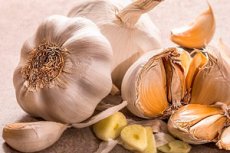
All iLive content is medically reviewed or fact checked to ensure as much factual accuracy as possible.
We have strict sourcing guidelines and only link to reputable media sites, academic research institutions and, whenever possible, medically peer reviewed studies. Note that the numbers in parentheses ([1], [2], etc.) are clickable links to these studies.
If you feel that any of our content is inaccurate, out-of-date, or otherwise questionable, please select it and press Ctrl + Enter.
Garlic for gastritis
Medical expert of the article
Last reviewed: 04.07.2025

The general recommendation for dietary nutrition for inflammation of the gastric mucosa is to avoid foods and drinks that usually irritate it, and eating raw garlic for gastritis is also not recommended in most cases. [ 1 ]
Is garlic ok for gastritis?
The main goal of a diet for gastritis is to reduce inflammation of the stomach, since the production of glycoprotein, that is, mucus that forms an internal protective layer on the epithelium of the stomach cavity, is disrupted. Therefore, gastroenterologists strongly advise their patients to limit the consumption of spicy vegetables and seasonings used in cooking, in particular, pepper (black, red, chili), garlic and onions, mustard, horseradish and nutmeg.
Clear contraindications for patients with hyperacid inflammation of the gastric mucosa: garlic for gastritis with high acidity is excluded from the diet. See: Diet for gastritis with high acidity
Can garlic be consumed with chronic gastritis? It depends on the level of acidity of the gastric juice, and if chronic gastritis is accompanied by increased acidity of the stomach, then garlic has no place in the diet, especially during periods of exacerbation of the disease.
Garlic is allowed in minimal quantities during periods of remission for atrophic gastritis with severe secretory insufficiency, i.e. low hydrochloric acid content in gastric juice.
More information in the articles:
Erosive gastritis can occur with either high or low acidity, and only in the case of insufficient secretion of hydrochloric acid in the stomach - provided there is no bleeding from its walls - can garlic be consumed in small quantities for erosive gastritis.
How to use garlic for gastritis with low acidity? It is recommended to add it to dishes, for example, to vegetable stew or sauces. Many people like boiled beets with garlic and sour cream for gastritis, but it should be borne in mind that the hydrogen index (pH) of beets is 4.9-6.6; sour cream has a pH of 4.6-4.7, and the approximate acidity of garlic fluctuates in the range of 5.3-6.3. Therefore, it is best to try to eat a very small amount of this salad at first to monitor your well-being.
But with hypertrophic gastritis, the process of digestion of food slows down, and eating garlic – in reasonable quantities – can activate it.
Indian gastroenterologists, following the traditions of Ayurveda (recognized by the WHO as one of the oldest traditional healing systems in the world), recommend that patients with gastritis include foods such as apples, cranberries, garlic and onions in their diet, as they help inhibit the growth of Helicobacter pylori bacteria, which cause inflammation of the gastric mucosa. [ 2 ]
According to research conducted by specialists from the National Chung Hsing University (Taiwan), polyphenols, flavonoids, alkaloids and other biologically active substances of some plants actively suppress the reproduction of H. pylori. Plants that demonstrate great potential in the fight against this bacterium include algae rich in carotenoids, green tea, garlic (its organosulfur compounds), apples (the polyphenols in their peel) and the root of Chinese ginger (Boesenbergia rotunda).
In addition, onions and garlic for gastritis with low acidity promote proper digestion and reduce gas formation in the intestines (flatulence).
However, with hyperacid gastritis, raw onions are contraindicated due to increased acidity of gastric juice.
Benefits
Whatever your attitude to garlic (Allium sativum), [ 3 ] the benefits of garlic, due to its unique composition, are not only tested in practice, but also scientifically proven. It contains more than three dozen biologically active sulfur compounds (thiosulfinates); amino acids and their glycosides; flavonoid quercetin, which exhibits antioxidant and anti-inflammatory properties; steroid saponins (eruboside-B, isoeruboside-B, sativioside); vitamins C and B6; potassium, calcium, phosphorus, iron, manganese, selenium.
But researchers associate the main medicinal value of garlic with sulfur compounds – alliin, allicin, ajoenes, vinyldithiins, diallyl and methylallyl, sallylcysteine, S-allylmercaptocysteine, etc., which are responsible for its taste and smell.
When crushed, garlic cloves release approximately 3.5 mg of the organosulfur compound allicin per gram. Allicin breaks down into ajoenes and vinyldithiins, which have been shown to have antithrombotic properties and are useful in preventing myocardial infarction and ischemic stroke.[ 4 ]
In addition, ajoenes act as antioxidants and have antimicrobial and antiviral effects. Garlic is able to fight many types of bacteria, including Escherichia coli, Salmonella enterica, Klebsiella aerogenes, Pseudomonas aeruginosa, Staphylococcus aureus, as well as Candida, Cryptococcus, Trichophyton, Epidermophyton, Microsporum, Aspergillus flavus fungi.
Regular consumption of garlic reduces cholesterol levels and helps lower blood pressure in arterial hypertension. Garlic reduces the manifestations of unstable angina, increases the elasticity of blood vessels and reduces occlusion of peripheral arteries.
The main flavonoid of garlic, quercetin, interacts with vitamins C and E to increase the activity of transferases and cytochrome P450 isoenzymes, promoting the detoxifying function of the liver.
Researchers explain the anti-cancer activity of raw garlic by inhibiting the growth and proliferation of tumor cells and stimulating their apoptosis.
However, excessive consumption of garlic may cause side effects such as nausea and heartburn, allergic reaction, flatulence and diarrhea, and an increased risk of bleeding.

